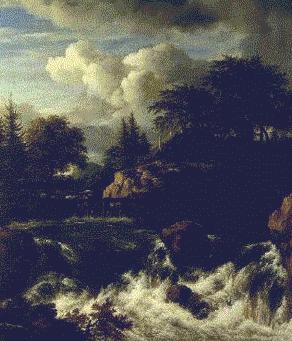
 The awareness of anything natural begins with perception, and this includes our awareness of what is Awesome in nature. But what is it that we perceive when we have a sense of the Awesome? According to Rudolph Arnheim, the author of several classic works on the psychology of Art, the natural mode of perception is less sophisticated than our 20th century mode of perception in terms of shape, size, proportion, and the like. "Visual perception," he says, "consists in the experiencing of visual forces." As humans were evolving in nature, their first concern was with survival; accordignly, they were not, as we are, especially interested in, or even aware of, the geometrical aspects of the things around them. Rather, their primary concern was with the natural forces that created and sustained these things. An organism, Arnheim continues, "is primarily interested in the forces active around it—the place, strength, direction." That is, what concerns these organisms primarily, as far as the evolution of perception is concerned, are the implications of the shape of objects and their natural environment about the forces that are present in them. And since physical "shapes are fossils of the events that gave rise to them", according to Arnheim, "the perceived impact of forces makes for what we call expression." That is, when we perceive things, what we "see" primarily, modern education not withstanding, are the forces expressed by things. And this explains what happens when we have a sense of Awe. Because of our sensitivity to the forces expressed by natural things, when we observe a natural scene or a work of art, we "see" many of the implications entailed in the objective forces. As Arnheim says, "the fact that all visual presence is visual action brings about expression, thus making it possible to use percepts as an artistic medium." The awareness of anything natural begins with perception, and this includes our awareness of what is Awesome in nature. But what is it that we perceive when we have a sense of the Awesome? According to Rudolph Arnheim, the author of several classic works on the psychology of Art, the natural mode of perception is less sophisticated than our 20th century mode of perception in terms of shape, size, proportion, and the like. "Visual perception," he says, "consists in the experiencing of visual forces." As humans were evolving in nature, their first concern was with survival; accordignly, they were not, as we are, especially interested in, or even aware of, the geometrical aspects of the things around them. Rather, their primary concern was with the natural forces that created and sustained these things. An organism, Arnheim continues, "is primarily interested in the forces active around it—the place, strength, direction." That is, what concerns these organisms primarily, as far as the evolution of perception is concerned, are the implications of the shape of objects and their natural environment about the forces that are present in them. And since physical "shapes are fossils of the events that gave rise to them", according to Arnheim, "the perceived impact of forces makes for what we call expression." That is, when we perceive things, what we "see" primarily, modern education not withstanding, are the forces expressed by things. And this explains what happens when we have a sense of Awe. Because of our sensitivity to the forces expressed by natural things, when we observe a natural scene or a work of art, we "see" many of the implications entailed in the objective forces. As Arnheim says, "the fact that all visual presence is visual action brings about expression, thus making it possible to use percepts as an artistic medium."
|

